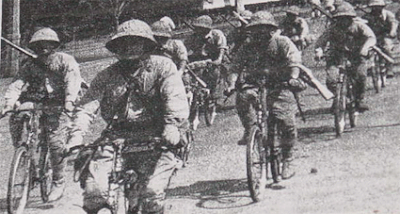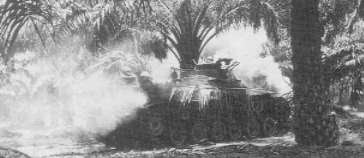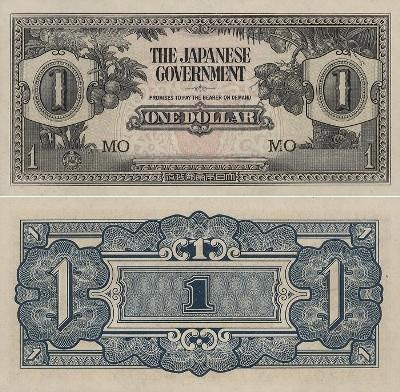 Japanese troops advancing through Kuala Lumpur
Japanese troops advancing through Kuala LumpurThe Japanese had attacked Malaya on the same day as the attack on Pearl Harbour. The Japanese who were much better trained and equiped swiftly took Malaya in less than two months far shorter than what the British took to control Malayan states from its rulers many years before.General Yamashita became known as the Tiger of Malaya for his successful conquest of Malaya.Singapore then fell although it had much more men than the Japanese and the British army surrendered.Soon after that British North Borneo,Brunei and Sarawak fell, luckily for the White Rajah of Sarawak, he and his family had gone to Australia before the invasion and stayed there during the duration of the war.
 Japanese soldiers moving through Malaya on bicycles
Japanese soldiers moving through Malaya on bicyclesFollowing the fall of Singapore on February 15,1942 the Japanese had designed banknotes for the use in Malaya,Brunei,British North Borneo and Singapore and introduced it as a replacement for the local cureency which at that time was the Malayan Dollar.These notes were to be exchanged at a rate of 1:1.The Japanese wanted everyone to exchange all Malayan Dollars for the Japanese Occupation banknotes and for those who did not comply with this rule would be severely punished by the authorities. Some people had hid some of their Malayan Dollars as they anticipated that it would be worth more when the British returned to become the rulers again.
 A Japanese tank in action somwhere in Malaya
A Japanese tank in action somwhere in Malaya
To supply the authorities with money whenever they required it, they simply printed more notes. This resulted in high inflation and a severe depreciation in value of the banana note. Moreover, counterfeiting was rampant due to its lack of a serial number on many notes. Increasing inflation coupled with Allied disruption of Japan's economy forced the Japanese administration to issue banknotes of larger denominations and increase the amount of money in circulation. Sharp drops in the currency's value and increased price of goods frequently occurred following a Japanese defeat in battle abroad.
 Japanese Navy A6M Zero fighters of 22nd Air Flotilla at Sultan Ismail Petra Airport after it was captured from Allied forces.
Japanese Navy A6M Zero fighters of 22nd Air Flotilla at Sultan Ismail Petra Airport after it was captured from Allied forces.
The Japanese had issued paper script currency of 1, 5, 10 and 50 cents and 1, 5 and 10 dollars in 1942. The 1, 5 and 10 dollar notes initially had serial numbers; these were later omitted. In 1944, inflation lead to the issuing of a 100 dollar note. In 1945, a replacement note 100 dollar bill was issued as well as a hyper-inflation 1,000 note. The 1942 series of notes, including the 50c and 1, 5, 10, and the 1944/45 100 dollar all contained the text [The Japanese Government] “Promise To Pay The Bearer On Demand”. Interestingly, the 1944 ,100 dollar replacement note no longer contained this message.No coins were issued during the occupation as the metals needed to produce was better used for the war effort, that is why the paper notes of 1,5,10 and 50 cents were issued instead of metal. Many people had stacks of these notes and going shopping was a troubling activity due to the fact that they had to carry bags of currency around
Many people had stacks of these notes and going shopping was a troubling activity due to the fact that they had to carry bags of currency around
 General Tomoyuki Yamashita,the Tiger of Malaya captured Malaya
General Tomoyuki Yamashita,the Tiger of Malaya captured Malaya
 A Japanese tank in action somwhere in Malaya
A Japanese tank in action somwhere in MalayaTo supply the authorities with money whenever they required it, they simply printed more notes. This resulted in high inflation and a severe depreciation in value of the banana note. Moreover, counterfeiting was rampant due to its lack of a serial number on many notes. Increasing inflation coupled with Allied disruption of Japan's economy forced the Japanese administration to issue banknotes of larger denominations and increase the amount of money in circulation. Sharp drops in the currency's value and increased price of goods frequently occurred following a Japanese defeat in battle abroad.
 Japanese Navy A6M Zero fighters of 22nd Air Flotilla at Sultan Ismail Petra Airport after it was captured from Allied forces.
Japanese Navy A6M Zero fighters of 22nd Air Flotilla at Sultan Ismail Petra Airport after it was captured from Allied forces.The Japanese had issued paper script currency of 1, 5, 10 and 50 cents and 1, 5 and 10 dollars in 1942. The 1, 5 and 10 dollar notes initially had serial numbers; these were later omitted. In 1944, inflation lead to the issuing of a 100 dollar note. In 1945, a replacement note 100 dollar bill was issued as well as a hyper-inflation 1,000 note. The 1942 series of notes, including the 50c and 1, 5, 10, and the 1944/45 100 dollar all contained the text [The Japanese Government] “Promise To Pay The Bearer On Demand”. Interestingly, the 1944 ,100 dollar replacement note no longer contained this message.No coins were issued during the occupation as the metals needed to produce was better used for the war effort, that is why the paper notes of 1,5,10 and 50 cents were issued instead of metal.
 Many people had stacks of these notes and going shopping was a troubling activity due to the fact that they had to carry bags of currency around
Many people had stacks of these notes and going shopping was a troubling activity due to the fact that they had to carry bags of currency aroundOne must be wondering how is it like during the occupation with all this inflated money,well In Theresa Ee-Chooi's biography of her father Ee Peng Liang, she noted that an egg went for $100. During the Japanese Occupation, $100 buys you one egg. Lee Chin Gee, son of Lee Choon Seng, a former chairman of OCBC, told the bank's biographers that he sold his wife's gold chain for $3,500. Yet that money was not enough to buy even two big fishes, so he settled for a medium-size fish and two bananas. Many people at that time could be seen going shopping with a big bag of this worthless money.After the war ended many people who were suffered so much during the occupation simply burned the money, imagine if they knew how much one piece of this worthless money is worth they would think twice before doing so.
 General Tomoyuki Yamashita,the Tiger of Malaya captured Malaya
General Tomoyuki Yamashita,the Tiger of Malaya captured MalayaThe 1,5,10 cents had prefixes of fractional letters and block letters.The 1,5 and 10 dollars with serial numbers are worth much more than the ones with block letters and they are quite rare to,finding one is a blessing for a collector of these invasion banknotes.The second type of the 100 dollar note with an image of rubber tapping is worth much more than the one with the two buffaloes behind the note.The first letter M on all notes represent Malaya the area where this currency should be used. Block letters prefix worth more
Block letters prefix worth more
 Fractional letters prefix worth more
Fractional letters prefix worth more
 Block letters worth more
Block letters worth more


 Serial numbered ones are expensive
Serial numbered ones are expensive
 Serial numbered ones are expensive
Serial numbered ones are expensive
 The second version of the 100 Dollar note(above),worth more than the common one (below)
The second version of the 100 Dollar note(above),worth more than the common one (below)

 Block letters prefix worth more
Block letters prefix worth more Fractional letters prefix worth more
Fractional letters prefix worth more Block letters worth more
Block letters worth more
If the prefix of the 1000 Dollar note is black instead of red, you just found yourself a small fortune
1 comment:
Join ka na!
Get COINnected now!
http://www.facebook.com/PinoyNumismatistNetwork
Post a Comment